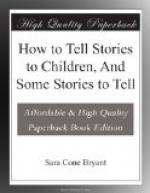The beginning and the end of a story decided upon, its body becomes the bridge from one to the other; in this case it is August’s strange journey, beginning with the catastrophe and his grief-dazed decision to follow the stove. The journey is long, and each stage of it is told in full. As this is impossible in oral reproduction, it becomes necessary to choose typical incidents, which will give the same general effect as the whole. The incidents which answer this purpose are: the beginning of the journey, the experience on the luggage train, the jolting while being carried on men’s shoulders, the final fright and suspense before the king opens the door.
The episode of the night in the bric-a-brac shop introduces a wholly new and confusing train of thought; therefore, charming as it is, it must be omitted. And the secondary thread of narrative interest, that of the prices for which the stove was sold, and the retribution visited on the cheating dealers, is also “another story,” and must be ignored. Each of these destroys the clear sequence and the simplicity of plot which must be kept for telling.
We are reduced, then, for the whole, to this: a brief preliminary statement of the place Hirschvogel held in the household affections, and the ambition aroused in August; the catastrophe of the sale; August’s decision; his experiences on the train, on the shoulders of men, and just before the discovery; his discovery, and the denouement.
This not only reduces the story to tellable form, but it also leaves a suggestive interest which heightens later enjoyment of the original. I suggest the adaptation of Kate Douglas Wiggin, in The Story Hour, since in view of the existence of a satisfactory adaptation it seems unappreciative to offer a second. The one I made for my own use some years ago is not dissimilar to this, and I have no reason to suppose it more desirable.
Ruskin’s King of the Golden River is somewhat difficult to adapt. Not only is it long, but its style is mature, highly descriptive, and closely allegorical. Yet the tale is too beautiful and too suggestive to be lost to the story-teller. And it is, also, so recognised a part of the standard literary equipment of youth that teachers need to be able to introduce children to its charm. To make it available for telling, we must choose the most essential events of the series leading up to the climax, and present these so simply as to appeal to children’s ears, and so briefly as not to tire them.
The printed story is eight thousand words in length. The first three thousand words depict the beauty and fertility of the Treasure Valley, and the cruel habits of Hans and Schwartz, its owners, and give the culminating incident which leads to their banishment by “West Wind.” This episode,—the West Wind’s appearance in the shape of an aged traveller, his kind reception by the younger brother, little Gluck, and the subsequent wrath of Hans and Schwartz, with




